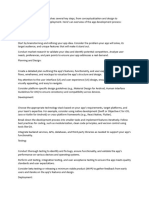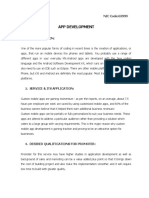2025
Riphah International
University
DATABASE SIR TANZEEL
ASSIGNMENT
HASHAAM | AF24SPA1256
�Name:
Hashaam Abdul Rehman
Roll No :
AF24SPA1256
Submitted To:
Sir Tanzeel
Subject:
Database
�Assignment 01
Topic
Imagine you are managing a project to
develop a simple mobile application.
Question: Describe how you would use the SDLC to handle this project.
Introduction:
In the world of technology, mobile apps are becoming more and more
important every day. People use apps for chatting, shopping, learning, playing games, and
many other things. That’s why creating a mobile app is not just a small task. It needs proper
planning and the right process to make sure the app works well and users like it.
To make sure the mobile application is developed properly, we can follow a method called
SDLC. SDLC stands for Software Development Life Cycle. It is a process that includes
different steps like planning, designing, coding, and testing. It helps developers to complete
a project in an organized way.
If I am the manager of a project to develop a simple mobile app, I will follow the steps of
SDLC from start to end. These steps will help me to make sure that the app is working well,
meets all the requirements, and is useful for the users. Below are the SDLC steps explained
in detail using simple and clear language.
1. Planning:
Planning is the first and most important step of SDLC. In this step, we think
about what kind of app we want to build and why. We decide the purpose of the app. For
example, the app may be for online shopping, health tips, taking notes, or providing weather
updates. We also decide who the app is for and what kind of features it will have.
In this step, we also create a proper schedule for the project. We think about how much
time it will take to complete the app and how many people we need in the team. We also
�calculate the budget for the app, which means how much money we need to spend. We
divide tasks among team members like developers, designers, and testers.
Good planning helps to make the work smooth and problem-free. If we do not plan properly,
we may face issues during development. Sometimes projects fail because they were not
planned well. That’s why this step is the foundation of the entire mobile app project.
2. Requirement Gathering:
After planning, the next step is to gather the
requirements from users or clients. This means we talk to the people who need the app and
ask them what they want. For example, we ask them what kind of features they need, what
the app should look like, and how the app should work.
We carefully write down all the answers from the client so we don’t forget anything. This
document is called the Requirement Document. It helps everyone on the team to
understand what the user expects. This also avoids any confusion in the later stages of
development.
Understanding user needs is very important because the app is being made for them. If we
don’t know what they want, we might make something that is useless for them. So this step
helps us to make sure we are going in the right direction and building an app that the user
will actually use and enjoy.
3. Design:
Once the requirements are clear, we move to the design step. In this step, we
create a basic structure or layout of the app. We make simple drawings or wireframes of
what each screen of the app will look like. This includes where the buttons will be, how the
menu will look, and what colors and icons we will use.
Another part of this step is designing the database. The database is where all the
information from the app is saved. For example, if the app has a login system, the database
will store usernames and passwords. We create tables in the database for storing user data,
product information, orders, etc.
Designing helps developers to get a clear picture of what they have to build. If the design is
done properly, development becomes easier and faster. It also helps the client to see how
the final app might look and give feedback early in the process.
4. Development:
� Development is the stage where the actual app is built. In this step, the
developers start writing the code for the app. They build both the front-end (what the user
sees on screen) and the back-end (how the app works behind the scenes). This step takes
time because every feature must be coded carefully.
The developers also connect the app with the database. This helps store and retrieve user
data like names, emails, passwords, messages, or shopping history. For example, when a
user registers, their information is saved in the database. When they log in later, the app
checks their details from the database.
This stage is the heart of the project. It requires technical skills and teamwork. A small
mistake in coding can cause bugs or errors in the app. That’s why developers work carefully
and check each function to make sure it’s working as expected.
5. Testing:
Once the app is developed, it must be tested properly. The testing team checks
the app and looks for bugs, errors, or anything that is not working. They test every part of
the app, including the login, menus, buttons, and database connection.
Testing also checks how the app works on different devices like phones, tablets, and
different screen sizes. The testers make sure the app doesn’t crash, the speed is good, and
the user can easily use the features. If there are any problems, they are sent back to the
developers to fix.
This step is very important because it ensures that the app is working smoothly before it is
launched. A small bug can create big problems after the app is live. So proper testing helps
to keep the app clean, user-friendly, and reliable.
6. Deployment:
After successful testing, the app is ready to be launched. This is called
the Deployment phase. In this step, the app is uploaded to platforms like the Google Play
Store or the Apple App Store, where users can download and install it on their devices.
Before launching, we also prepare a description for the app, add screenshots, and set up
permissions. We make sure everything is ready for users. After the app is live, we monitor its
performance and look for feedback from users.
Deployment is a happy moment for the whole team because the app they worked on is now
available to the public. It is also a serious moment because any issues after launch must be
solved quickly. So, a lot of attention is given during this step.
7. Maintenance:
� Even after the app is launched, the work doesn’t stop. In the
Maintenance stage, we keep checking the app for errors, bugs, or new updates. Users may
report issues or request new features. The development team handles these tasks regularly.
We also release new versions of the app with extra features, improved design, or better
performance. This helps in keeping users happy and interested in using the app. For
example, adding dark mode or new payment options can improve user experience.
Maintenance is very important to keep the app useful and secure. If an app is not updated
for a long time, users may stop using it. So regular maintenance keeps the app alive and
running successfully for years.
Conclusion:
The SDLC is a complete and helpful process for managing app development.
Every step has its own importance and helps the team work in an organized and effective
way. From planning to deployment and maintenance, each phase plays a key role in making
the app successful.
By using SDLC, we make sure the app is not only made correctly but also useful for the users.
It saves time, reduces mistakes, and helps in achieving the goal smoothly. Whether the app
is big or small, SDLC makes the project easier to manage.
So, if I am managing a mobile app project, I will definitely follow the SDLC method. It will
help me lead the team, satisfy the users, and deliver a working app that is smart, useful, and
ready for the real world.
































































































